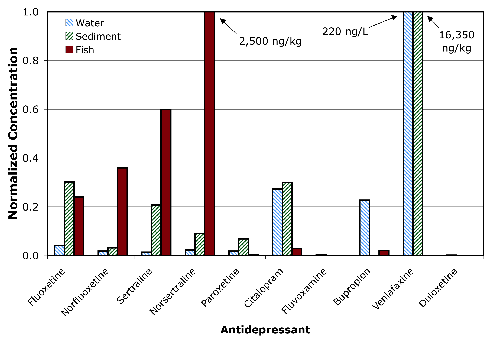Antidepressants in Stream Waters! Are They in the Fish Too?

USGS scientist removing the brain from a fish (a white sucker) collected from Fourmile Creek near Ankeny, Iowa. The scientists tested the fish's brain for the presence of antidepressant drugs. Traces of antidepressant drugs were found in fish and also in the water from Fourmile Creek.
(Larger Version)
|
|
For some fish living downstream of sewage treatment plants the answer is yes. U.S. Geological Survey (USGS) scientists and their colleagues published a paper in Environmental Science and Technology documenting that specific antidepressants and their degradates found in wastewater discharged into streams by municipal wastewater treatment plants are taken up into the bodies of fish living downstream of the plants. The antidepressants were found in fish collected over 8 kilometers (approximately 5 miles) downstream of the location of the wastewater discharge. The scientists detected several commonly used antidepressants in water, streambed sediment, and the brain tissue of white suckers, a native fish species. Fish collected upstream from the wastewater discharge did not have antidepressants present in their brain tissues. The study was conducted in two streams, Boulder Creek near Boulder, Colorado, and Fourmile Creek near Ankeny, Iowa.
More of What the Scientists Found
- This study is the first to demonstrate that the concentrations of these antidepressants in stream waters do not necessarily correlate with the concentrations or presence of antidepressants that are found in fish tissue. Other factors come into play that determine which antidepressants are taken up by the fish.
-
The most frequently detected antidepressants in wastewater and stream water were venlafaxine, bupropion, and citalopram. In contrast, the most frequently detected antidepressants in fish brains were fluoxetine, norfluoxetine (a transformation product of fluoxetine), sertraline, and norsertraline (a transformation product of sertraline).
-

Average concentrations of antidepressants in water, sediment, and fish neural tissue from Boulder Creek just below the point where wastewater from a sewage treatment plant is discharged (USGS Site ID 400305105103901). Since concentration units differed for each sample type, the concentrations were normalized to the highest single antidepressant concentration in each sample type (highest concentration was set to equal one). The graph shows that fish selectively absorb some antidepressants more than others.
(Larger Version)
|
|
The scientists collected the brains of white suckers because antidepressants are designed to modulate the concentrations of brain chemicals called neurotransmitters (such as serotonin, norepinephrine, and dopamine). Thus, brains are the location in fish most likely to be affected by antidepressants.
The study was conducted in collaboration with scientists from the College of Wooster, Ohio; St. Cloud State University, Minnesota; and the University of Colorado at Boulder.
References
Schultz, M.M., Furlong, E.T., Kolpin, D.W., Werner, S.L., Schoenfuss, H.L., Barber, L.B., Blazer, V.S., Norris, D.O., and Vajda, A.M., 2010, Antidepressant pharmaceuticals in two U.S. effluent-impacted streams--Occurrence and fate in water and sediment, and selective uptake in fish neural tissue: Environmental Science and Technology, doi:10.1021/es9022706 (Advanced Web release).
Painter, M.M., Buerkley, M.A., Julius, M.L., Vajda, A.M., Norris, D.O., Barber, L.B., Furlong, E.T., Schultz, M.M., and Schoenfuss, H.L., 2009, Antidepressants at environmentally relevant concentrations affect predator avoidance behavior of larval fathead minnows (Pimephales promelas): Environmental Toxicology and Chemistry, v. 28, no. 12, p. 2677-2684, doi:10.1897/08-556.1.
More Information
"The most important observation in our study is that you cannot necessarily predict which antidepressants are present in aquatic tissue from antidepressant concentrations in the water the organisms are living in. This study clearly documents selective uptake of specific antidepressants into fish brain tissue that were minor components in corresponding water samples. There are many reasons why this selective uptake may occur - including differences in fat versus water solubilities of the targeted antidepressants - but these results suggest other, as yet unidentified mechanisms may also be involved that warrant further study.
We also do not yet fully understand the implications for fish health and populations from exposure to these antidepressants. However, we have collaborated in laboratory experiments (Painter and others, 2009) documenting a slowed predator avoidance behavior in larval fathead minnows exposed to antidepressant concentrations similar to those observed in this study. A slower response to predators is probably not helpful when you are on the lower end of the food chain."
Edward Furlong, USGS research chemist, corresponding author
|
|
Related Headlines
Back to Headlines Page |

|